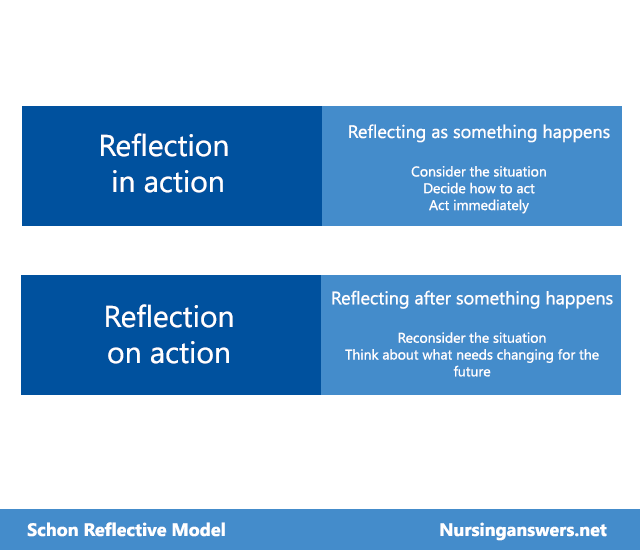Introduction
The Schön reflective model presents the concept of 'reflection in action' and 'reflection on action':
Reflection in action
- Experiencing
- Thinking on your feet
- Thinking about what to do next
- Acting straight away
Reflection on action
- Experiencing
- Thinking on your feet
- Thinking about what to do next
- Acting straight away
Reflection according to Donald Schon is the ability of professionals to ‘think what they are doing while they are doing it’. He states that managing the indeterminate zones of professional practice requires the ability to think on the run and use previous experience to new conditions. This is important and needs the ability to reflect-in-action.

What does Schon say about reflection?
Reflective practicum
“A practicum is a setting created for the task of learning a practice” D. Schon (1983). This links to learners learning by doing, with the tutor’s assistance. The practicum is ‘reflective’ in two reasons: “it’s intention of helping learners becoming proficient in a type of reflection-in-action, and when it functions properly, it entails a tutor – learner dialogue of teacher taking the form of reciprocal reflection-in-action.”
- (Argyris and Schon 1978)
Tacit knowledge
Arises from Michael Polanyi’s work where he describes the ability of picking out a familiar face in a crowd, without any thought, or a systematic features analysis. We cannot tell how this is done; hence the knowledge is ‘unspoken’ or ‘tacit’
Knowing-in-action
Is also Schon’s idea which stems from the tacit knowledge concept. It is a type of knowledge that can be revealed in the manner we perform our duties and tackle problems. “The knowing is in the action. It is shown by the skilful execution of the performance – we are notably not able to make it verbally explicit.” This tacit knowledge is obtained from investigations and also from the practitioner’s own reflections and experience.)
Reflection-in-action
Occurs whilst a problem is being addressed, in what Schon termed the ‘action-present’. It is reflection during the ‘doing’ stage (that is, reflecting on the incident while it can still benefit the learning). This is carried out during practice rather than reflecting on how you would do things differently in the future. This is seen as an efficient method of reflection as it allows you to react and change an event at the time it happens. It also allows you to deal with surprising incidents that may happen in a learning environment. It allows you to be responsible and resourceful, drawing on your own knowledge and allowing you to apply it to new experiences.
Reflection-on-action
Is reflection after the event. It involves reflecting on how practice can be developed after it has happened. Schön recognises the importance of reflecting back ‘in order to discover how our knowing-in-action may have contributed to an unexpected outcome’ (Schön, 1983). Reflection-on-action should encourage ideas on what you need to change for the future.
Operative attention
Relates to the readiness to use new information. This concept is partly obtained from Wittgenstein’s contention that the meaning of an operation can only be learned through its performance. It prepares the student for feedback on that activity and builds understanding.
The ladder of reflection
Schön speaks of a vertical dimension of analysis that can happen in the dialogue between learner and teacher. To move up a rung on the ladder involves reflecting on an activity. To move down a rung is to move from reflection to experimentation. This ladder has more than two rungs – it is also possible to reflect on the process of reflection. The importance of this concept is in its potential for helping out with ‘stuck’ situations in learning. Being able to move to another level may assist coach and learner to achieve together what Schön refers to as ‘convergence of meaning’.
Evaluation of Schön's Model
By following Schon's model of reflection, you will have a questioning approach to your nursing practice. You will consider why things are as they are, and how they could be. You will consider the strengths and areas of development in your own practice as a nurse, questioning why learning experiences might be this way and considering how to develop them. As a result, what you do will be carefully planned, informed by research and previous experience, and focused, with logical reasons. As with all reflective models, it's important to repeat the cycle to make sure knowledge is secure and progression is continued.
Cite This Work
To export a reference to this article please select a referencing style below:

